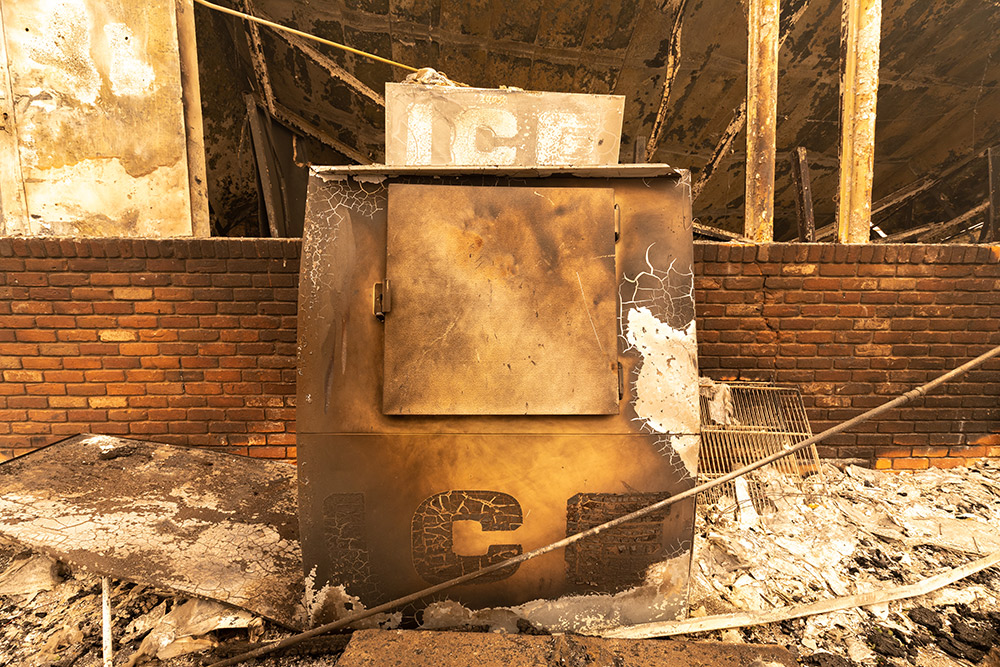近六年前,在盛大的巴黎气候峰会上,在一群公司——主要是保险和再保险业的巨头,也包括希望向可再生能源转型的欧洲能源公司——努力推动11个小时后,各方与弱势国家的代表和环保游说团体结成了一个不寻常的联盟,为后来的《巴黎协定》(Paris Agreement)的一项决定性条款添加了一项内容。
新内容是在各方就确保地球升温不超过工业革命前2℃达成一致后添加的。新内容增加了十个关键词:“......并努力将气温升幅控制在1.5℃以内。”环保人士欢呼称,这是一场胜利。
8月9日,联合国政府间气候变化专门委员会(Intergovernmental Panel on Climate Change)表示,《巴黎协定》定下的将气温升幅控制在1.5℃以内的宏大目标肯定无法实现。
若想应对气候变化,则离不开私营部门的努力。

政府间气候变化专门委员会是联合国(United Nations)旗下的一个机构,它的成立是为了整合近200个成员国的数千名科学家的工作成果。8月9日发布的第六份IPCC评估报告,包含创纪录的234位作者的研究成果。其中一个明确的结论是:人类是气温上升的罪魁祸首。
该报告列出了五种可能发生的情况,每种情况都假设在1850年至2019年期间全世界产生的约2.4万亿吨二氧化碳的基础上增加不同数量的温室气体排放,会发生什么。
最好的情况
在最乐观的情况下,即到2050年全球温室气体排放量降至净零的情况下,全球气温在未来20年仍将上升至少1.5℃。即便是在最好的情况下,全球海洋变暖的幅度也会较1971年至2018年期间翻一番,海洋生物会因为缺氧和酸度增加而遭到严重破坏。海平面会上升近1英尺(0.3048米),冰川会继续融化到本世纪末。极端天气将变得更加普遍,更加强烈。
最坏的情况
自1850年以来,全球气温已经上升了1.1℃,因此那些变化将来自于未来20年气温再上升0.4℃。最坏的情况预测,到2100年,全球气温将上升超过4.5℃,后果会像后末世小说描述的那样:每四年发生一次百年一遇的天气事件,世界上的部分人口最稠密的地区变得不可居住,粮食严重短缺。沿海城市和岛屿国家会陷入特别危险的境地。难怪联合国秘书长安东尼奥•古特雷斯称8月9日的报告是“人类的红色警报”。
气候活动家们希望,政府间气候变化专门委员会在报告中强调的可怕而详尽的描述,将会促使各方采取强有力的行动。有很多证据表明,八年前在巴黎峰会前发布的上一份该委员会的报告,确实促使政府、企业和个体有所行动。最新的报告——发布于一个史无前例的热浪、干旱、森林大火和洪水频发的夏季——是否会刺激各界采取进一步行动呢?
企业界正在觉醒
“我认为,在过去几年里,企业已经意识到气候风险,毕竟这些风险的影响在以超出我们预期的速度显现出来,”可持续发展科学家、最近发布的气候行动呼吁著作《Under the Sky We Make》的作者金伯利•尼古拉斯表示。“与任何其他部门一样,企业也会从稳定、可预测的气候环境中受益。我们越是任由气候变暖,企业就越是难以适应。”
尼古拉斯指出,撰写政府间气候变化专门委员会报告的科学家们在概述气候变化即将引发的种种影响方面做得很好。“现在,企业和其他利益相关者是时候共同寻找方法,尽快将他们所做的事情去碳化。”她说道。
政府间气候变化专门委员会计划发布三份概述全球气候风险的报告,8月9日的报告是第一份,也是最广泛的一份。第三份报告定于2022年3月发布,将重点关注缓解气候变化,这是企业可以发挥最大影响的领域。但不难猜测它会说些什么:今年早些时候,欧盟(European Union)估计,在截至2019年的40年期间,超过80%的天气相关损失与气候变化直接或间接关联。欧盟甚至列出具体的数字来反映这种气候灾难的危害程度:仅在欧洲经济区经济损失就达到5500亿美元。随着时间的推移,破坏性的气候影响愈演愈烈,超过一半的总损失是过去十年造成的。
当第三份政府间气候变化专门委员会报告发布时,下一个大型气候峰会——定于10月31日在苏格兰举行的第26届联合国气候变化大会(26th UN Climate Change Conference)——将已经举行完毕。在气候行动的倡导者看来,这些会谈是企业、政府和其他利益相关者再次联合采取行动限制最可怕的气候情况的最后机会,也是最好的机会,就像他们这次在巴黎所做的那样。
“即将召开的这次会议是关于确定性的。”秘鲁环境部前部长、世界自然基金会(WWF)气候和能源部门负责人曼努埃尔•普尔加-维达尔告诉《财富》杂志,“我们需要搞清楚气候危机的规模以及人为因素在引发极端天气事件上的作用。我们不能错过这个采取强有力行动的机会。机会可能不会再来。”(财富中文网)
译者:万志文
近六年前,在盛大的巴黎气候峰会上,在一群公司——主要是保险和再保险业的巨头,也包括希望向可再生能源转型的欧洲能源公司——努力推动11个小时后,各方与弱势国家的代表和环保游说团体结成了一个不寻常的联盟,为后来的《巴黎协定》(Paris Agreement)的一项决定性条款添加了一项内容。
新内容是在各方就确保地球升温不超过工业革命前2℃达成一致后添加的。新内容增加了十个关键词:“......并努力将气温升幅控制在1.5℃以内。”环保人士欢呼称,这是一场胜利。
8月9日,联合国政府间气候变化专门委员会(Intergovernmental Panel on Climate Change)表示,《巴黎协定》定下的将气温升幅控制在1.5℃以内的宏大目标肯定无法实现。
若想应对气候变化,则离不开私营部门的努力。
美国加利福尼亚州格林维尔社区遭到迪克西大火(Dixie Fire)肆虐,在一个被烧毁的加油站,冰柜不再运转。
政府间气候变化专门委员会是联合国(United Nations)旗下的一个机构,它的成立是为了整合近200个成员国的数千名科学家的工作成果。8月9日发布的第六份IPCC评估报告,包含创纪录的234位作者的研究成果。其中一个明确的结论是:人类是气温上升的罪魁祸首。
该报告列出了五种可能发生的情况,每种情况都假设在1850年至2019年期间全世界产生的约2.4万亿吨二氧化碳的基础上增加不同数量的温室气体排放,会发生什么。
最好的情况
在最乐观的情况下,即到2050年全球温室气体排放量降至净零的情况下,全球气温在未来20年仍将上升至少1.5℃。即便是在最好的情况下,全球海洋变暖的幅度也会较1971年至2018年期间翻一番,海洋生物会因为缺氧和酸度增加而遭到严重破坏。海平面会上升近1英尺(0.3048米),冰川会继续融化到本世纪末。极端天气将变得更加普遍,更加强烈。
最坏的情况
自1850年以来,全球气温已经上升了1.1℃,因此那些变化将来自于未来20年气温再上升0.4℃。最坏的情况预测,到2100年,全球气温将上升超过4.5℃,后果会像后末世小说描述的那样:每四年发生一次百年一遇的天气事件,世界上的部分人口最稠密的地区变得不可居住,粮食严重短缺。沿海城市和岛屿国家会陷入特别危险的境地。难怪联合国秘书长安东尼奥•古特雷斯称8月9日的报告是“人类的红色警报”。
气候活动家们希望,政府间气候变化专门委员会在报告中强调的可怕而详尽的描述,将会促使各方采取强有力的行动。有很多证据表明,八年前在巴黎峰会前发布的上一份该委员会的报告,确实促使政府、企业和个体有所行动。最新的报告——发布于一个史无前例的热浪、干旱、森林大火和洪水频发的夏季——是否会刺激各界采取进一步行动呢?
企业界正在觉醒
“我认为,在过去几年里,企业已经意识到气候风险,毕竟这些风险的影响在以超出我们预期的速度显现出来,”可持续发展科学家、最近发布的气候行动呼吁著作《Under the Sky We Make》的作者金伯利•尼古拉斯表示。“与任何其他部门一样,企业也会从稳定、可预测的气候环境中受益。我们越是任由气候变暖,企业就越是难以适应。”
尼古拉斯指出,撰写政府间气候变化专门委员会报告的科学家们在概述气候变化即将引发的种种影响方面做得很好。“现在,企业和其他利益相关者是时候共同寻找方法,尽快将他们所做的事情去碳化。”她说道。
政府间气候变化专门委员会计划发布三份概述全球气候风险的报告,8月9日的报告是第一份,也是最广泛的一份。第三份报告定于2022年3月发布,将重点关注缓解气候变化,这是企业可以发挥最大影响的领域。但不难猜测它会说些什么:今年早些时候,欧盟(European Union)估计,在截至2019年的40年期间,超过80%的天气相关损失与气候变化直接或间接关联。欧盟甚至列出具体的数字来反映这种气候灾难的危害程度:仅在欧洲经济区经济损失就达到5500亿美元。随着时间的推移,破坏性的气候影响愈演愈烈,超过一半的总损失是过去十年造成的。
当第三份政府间气候变化专门委员会报告发布时,下一个大型气候峰会——定于10月31日在苏格兰举行的第26届联合国气候变化大会(26th UN Climate Change Conference)——将已经举行完毕。在气候行动的倡导者看来,这些会谈是企业、政府和其他利益相关者再次联合采取行动限制最可怕的气候情况的最后机会,也是最好的机会,就像他们这次在巴黎所做的那样。
“即将召开的这次会议是关于确定性的。”秘鲁环境部前部长、世界自然基金会(WWF)气候和能源部门负责人曼努埃尔•普尔加-维达尔告诉《财富》杂志,“我们需要搞清楚气候危机的规模以及人为因素在引发极端天气事件上的作用。我们不能错过这个采取强有力行动的机会。机会可能不会再来。”(财富中文网)
译者:万志文
Nearly six years ago, at the big Paris climate summit, an 11th-hour push by a group of companies—mostly the giants of insurance and reinsurance, but also European energy companies looking to the make the transition to renewables—struck an unusual alliance with delegations from vulnerable countries and environmental lobby groups, adding a few words to a defining article of what was to become the Paris Agreement.
The new language was inserted after the consensus of limiting average temperature increases to “well below 2°C” compared to pre-industrial levels, adding ten key words: “…and pursuing efforts to limit the temperature increase to 1.5°C.” Environmentalists hailed the new language as a victory.
On August 9, the Intergovernmental Panel on Climate Change (IPCC) said the ambitious 1.5°C language of the Paris treaty is almost surely out of reach.
Climate: one. Private sector: zero.
The IPCC, a United Nations body, was created to synthesize the work of thousands of scientists in nearly 200 member states. Its sixth assessment report, released on August 9, featured the work of a record 234 authors. Among unequivocal conclusions: humanity is to blame for rising temperatures.
The report charts five potential scenarios, each assuming different quantities of greenhouse-gas emissions added to the estimated 2.4 trillion tons of carbon dioxide the world generated between 1850 and 2019.
Best case
In the most optimistic scenario, one that would see global emissions drop to net-zero by 2050, global temperatures will still rise by at least 1.5°C over the next 20 years. The warming of the world’s oceans experienced between 1971 and 2018 would double even under the best-case scenario, with marine life devastated by a loss of oxygen and increased acidity. Sea levels would rise by nearly a foot and ice sheets would continue to melt through the end of the century. Extreme weather will become more common and more intense.
Worst case
The world has already registered 1.1°C in warming since 1850, so those changes will come from an additional 0.4°C of warming over the next two decades. The worst-case scenario predicts a total increase of more than 4.5°C by 2100, and consequences that read like post-apocalyptic fiction: once-in-a-century weather events every four years, some of the world’s most densely populated areas becoming inhabitable, and severe food shortages. Coastal cities and island nations would be in particular peril. No surprise that Antonio Guterres, UN secretary-general, called August 9’s report “a code red for humanity.”
The hope among climate activists is that the dire and detailed descriptions highlighted by the IPCC will prompt strong action. There's plenty of evidence to show the last IPCC report, released eight years ago in the lead-up to the Paris summit, did help spark a modest uptick in government, corporate, and individual action. Will this report—released during an unprecedented summer of heatwaves, drought, wildfires, and floods—spur further action?
Business is waking up
“I think that over the last few years businesses have been waking up to climate risks as the impacts show themselves at a faster rate than we expected,” Kimberly Nicholas, a sustainability scientist and author of the recently-released call to climate action Under the Sky We Make, said. “As much as any other sector, businesses benefit from a stable, predictable climate. The more we let the climate warm, the harder it is to adapt.”
Nicholas noted that the scientists who produced the IPCC report did a good job in outlining the approaching impacts of climate change. “Now it’s the time for business and other stakeholders to find a way to decarbonize what they do as quickly as possible,” she said.
August 9’s report is the first and the broadest of the three IPCC reports outlining global climate risks. The third, set to be released in March 2022, will focus on climate mitigation, the area where businesses can have the biggest impact. But it’s not hard to guess what it will say: earlier this year, the European Union estimated that more than 80 percent of the weather-related damage over a 40-year period ending in 2019 was directly or indirectly related to climate change. It even attached a price tag to that climate carnage, totaling nearly $550 billion in the European Economic Area alone. The sting in the tail: the damaging climate impacts broadly grew over time, with more than half the total losses coming in the last decade.
By the time the third report is released, the next big climate summit—the 26th UN Climate Change Conference, scheduled to get underway Oct. 31 in Scotland—will have come and gone. Advocates of climate action are hailing those talks as the last, best chance for business, government, and other stakeholders to join forces again as they did in Paris this time with action that will help limit the most terrifying scenarios.
“This upcoming conference is about certainty,” Manuel Pulgar-Vidal, a former Peruvian minister of environment who is now head of the climate and energy section for WWF, told Fortune. “We need certainty on the scale of the climate crisis and on humankind’s role in driving extreme weather events. We cannot miss this opportunity to deliver strong action. We may not get another.”






